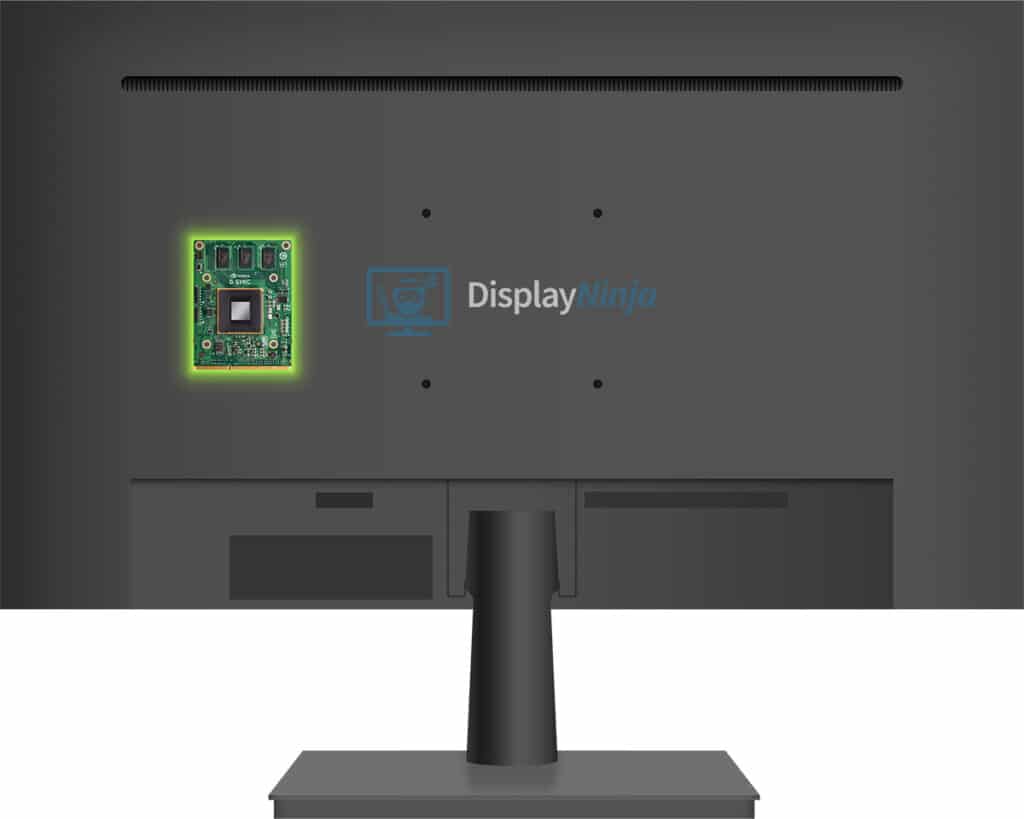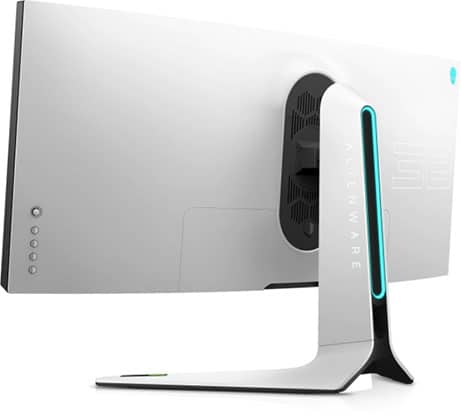Bottom Line
The Dell Alienware AW3821DW delivers both an immersive and responsive gaming experience thanks to its 38″ 3840×1600 144Hz IPS panel with fast response time, vibrant colors, G-SYNC, and DisplayHDR 600.
However, it’s not cheap and has its share of downsides that you should familiarize yourself with in order to ensure this gaming monitor is right for you.
If you’re after a 38″ ultrawide gaming monitor, the Dell Alienware AW3821DW is the only model that offers both a native G-SYNC module and DisplayHDR 600 certification, yet it is competitively priced. Here’s what you need to know about it and its alternatives.
Image Quality
Based on a Nano IPS panel, the Dell Alienware AW3821DW monitor delivers vibrant colors, covering over 95% of the DCI-P3 color space.
Its gamut is equivalent to ~131% sRGB, which provides rich and saturated colors with improved shade variety, especially with reds and greens.
Alas, Dell/Alienware didn’t include an sRGB emulation mode that could restrict the panel’s wide color gamut to ~100% sRGB for an accurate color representation of sRGB content (most games and web content).
This means that most of the content you see will be over-saturated. Some users might prefer this extra color vibrancy, but it’s not the intended look by creators.
Alternatively, if you have an AMD graphics card, you can clamp the gamut via the Radeon software by enabling ‘Custom Color.’ For NVIDIA users, there’s a third-party tool called novideo_srgb that does the same (and more).

Apart from that, the colors are vibrant, precise, and consistent across the entire screen and at all times thanks to the wide 178° viewing angles of the IPS technology.
Moving on, thanks to the monitor’s high 3840×1600 resolution, details and text are crystal-clear and you get plenty of screen space.
On the 37.5″ viewable screen, you get a pixel density of ~110 PPI (pixels per inch), which many consider to be the sweet spot as you don’t have to use any scaling yet you get a lot of screen real estate and a crisp picture.
Note that such high resolution is quite demanding to drive, so check some benchmarks of your CPU/GPU at 3840×1600 to see if you’ll get a satisfactory frame rate in your favorite games.
The ultrawide resolution also provides you with a more immersive gaming experience as you get a wider field of view (in supported games). 21:9 movies (2.35:1 or 2.39:1 to be precise) will also look great, without black borders at the top and bottom of the screen.
16:9 videos and unsupported games will have black bars at the sides of the screen, though. Alternatively, you can stretch or crop/zoom the image to fill the screen.
For reference, a 38″ ultrawide display is almost as tall as a regular 32″ monitor (30″ exactly) but ~20% wider.
The Dell AW3821DW has a strong 450-nit peak brightness, which gets a boost up to 600-nits when watching HDR (High Dynamic Range) content for more vivid and punchy highlights.
Additionally, there are 32 dimming zones that can dim parts of the image that need to be dark without greatly affecting parts of the screen that should remain bright.
This can make HDR content appear significantly more immersive, but since there are only 32 zones across the entire 38″ screen and since the native contrast ratio is mediocre at 1,000:1, only some HDR scenes with bright and dark objects far apart will look notably better.
In other words, you’re not getting the ‘true’ HDR viewing experience. Some HDR content will look much better, some will look worse, and some will be just okay.
Another thing to keep in mind about IPS panel monitors is IPS glow. It’s characterized as a visible ‘glow’ around the corners of the screen. It’s mostly noticeable when watching really dark scenes in a dark room with high brightness setting.
The amount of IPS glow varies across different units of monitors, just like other defects, such as backlight bleeding, dead/stuck pixels, etc., but in most cases, it’s tolerable or negligible.
Performance

What drawbacks the Dell Alienware AW3821DW has regarding image quality, it makes up for when it comes to performance.
To start with, the monitor has imperceptibly low input lag at just ~4ms, while its 1ms GtG pixel response time speed is quick enough to eliminate ghosting behind fast-moving objects across the entire refresh rate range, without adding any noticeable overshoot.
There are three response time overdrive modes: Fast, Super Fast, and Extreme. We recommend sticking with the ‘Fast’ option, as the other two modes add too much inverse ghosting.
The monitor has a native G-SYNC module, which prevents screen tearing and stuttering up to 144FPS by providing you with a variable refresh rate (VRR) if you have a compatible graphics card (GTX 650 Ti Boost or newer).
As it uses one of the newer G-SYNC modules, variable refresh rate is also supported when using AMD graphics cards.
The Dell Alienware AW3821DW is branded as ‘G-SYNC Ultimate’, but unlike the initial several monitors with this certification, it doesn’t offer as good HDR image quality since it lacks full-array local dimming (FALD).
The G-SYNC Ultimate certification here simply implies that the monitor has a native G-SYNC module and ‘lifelike HDR.’
The first G-SYNC Ultimate certification requirements were much more demanding, including a 1,000-nit peak brightness and FALD, like the 384-zone or 512-zone FALD implementations of the ASUS PG27UQ and the Acer X35, respectively.
These two displays offer a much better (or ‘true’) HDR viewing experience, but they’re also more expensive due to the FALD solutions.
Features

The OSD (On-Screen Display) menu of the Dell AW3821DW is well-organized and easy to work with thanks to the directional joystick placed at the rear of the monitor.
Below the joystick, you’ll find four additional hotkeys, three of which can be assigned to different shortcuts, while the power button is placed beneath the bottom bezel of the screen.
Noteworthy features include various picture presets, such as Standard, FPS, MOBA/RTS, RPG, Sports, three customizable Game profiles, and ComfortView (applies a low-blue light filter).
The backlight of the monitor is flicker-free as it doesn’t use PWM (Pulse-Width Modulation) to regulate brightness meaning that those sensitive to flickering won’t get headaches after prolonged use.
Under Game Enhance Mode, you’ll find a customizable on-screen timer, a refresh rate tracker, and Display Alignment for easier alignment of multiple windows.
Dark Stabilizer alters the gamma curvature for better visibility in dark scenes, while Variable Backlight adjusts the speed and effectiveness of the local dimming zones (Mode 0 for gameplay, Mode 1 for mixed-use, Mode 2 for desktop use, and ‘Off’).
Note that you can’t disable local dimming with HDR content, which is a shame since with some content, the local dimming solution can be more distracting than useful.
There’s also an ambient light sensor that will dynamically change the monitor’s brightness according to ambient lighting once enabled.
Other settings include the standard image adjustment tools (brightness, contrast, input source selection, etc.), but some advanced features are missing.
There are no gamma, sharpness, or hue/saturation settings – and there are only three color temperature modes (Warm, Cool, and Custom). You also won’t find Picture in Picture or Picture by Picture.
The RGB lighting settings, on the other hand, are plentiful.
The Alienware logo and LEDs across the back of the monitor’s stand can be customized to glow in various colors and patterns. You can customize these settings in the OSD menu or via the Alienware Command Center desktop application.
While the RGB lighting customization is generous, LEDs aren’t strong enough to reflect off of the wall for atmospheric lighting – and you can’t sync it to on-screen video or audio.
Design & Connectivity

The Dell Alienware AW3821DW boasts premium build quality and a versatile stand with up to 130mm height adjustment, -5°/21° tilt, +/- 20° swivel, and 100x100mm VESA mount compatibility.
Further, the screen has a matte anti-glare screen coating that prevents reflections, while the subtle 2300R curvature adds to the immersion.
Connectivity options include DisplayPort 1.4, two HDMI 2.0 ports, a headphone jack, an audio line-out port for external speakers, and a quad-USB 3.0 hub.
Note that HDMI 2.0 is limited to 85Hz at 3840×1600.
For 10-bit color depth at 3840×1600 over DisplayPort 1.4, you’ll need to use chroma subsampling at 144Hz or lower the refresh rate to 120Hz.
Unlike the other 38″ ultrawide gaming monitors based on the same panel with G-SYNC, the Dell Alienware AW3821DW doesn’t offer a factory-overclocked refresh rate, though you could try overclocking it manually.
The G-SYNC module also has a cooling fan, which depending on the unit and your personal sensitivity, can be somewhat noisy.
Price & Similar Monitors
The Dell Alienware AW3821DW can be found for as low as ~$800, which makes it one of the most affordable 38″ ultrawide gaming monitors available yet it features a dedicated G-SYNC module.
Another good option is the Acer XR383CUR P 38″ 3840×1600 165Hz IPS gaming monitor with HDMI 2.1, USB-C (65W PD) and DisplayHDR 600. It can also be found for $800 on sale.
There are a few more 38″ models, but they’re usually overpriced. These include two more 38″ G-SYNC models, the Acer X38P and the LG 38GL950G – and two FreeSync models, the LG 38GN950 and the Thunderbolt 3 variant, the LG 38WN95C.
We also recommend checking out the Dell AW3423DWF in this price range.
It has a QD-OLED panel with an infinite contrast ratio, a higher peak brightness, a wider color gamut and no backlight bleeding or similar artifacts. On top of that, it supports VRR up to 165Hz and has instantaneous pixel response time, resulting in much better HDR image quality and gaming performance.
In case you don’t care for HDR or OLED technology, we recommend the AW3821DW for gaming and the Acer XR383CURP or the LG 38WN95C if you have a laptop with Thunderbolt 3/USB-C.
Conclusion
The Dell Alienware AW3821DW offers an immersive and responsive SDR gaming experience.
Thanks to its low input lag, quick response time, high refresh rate and G-SYNC, you can enjoy smooth gameplay without any visual artifacts, while the vibrant colors, big screen with high resolution and strong peak brightness take the picture quality to the next level.
While it can’t be factory-overclocked like the other G-SYNC models, we find that 144Hz is plenty at 3840×1600, and the difference between 144Hz and ~170Hz would be hardly noticeable anyway.
However, if you don’t mind having a smaller display, the Dell AW3423DWF offers a much better HDR image quality and performance for the same price.
Specifications
| Screen Size | 37.5-inch |
| Screen Curvature | 2300R |
| Resolution | 3840×1600 (UWQHD+) |
| Panel Type | Nano IPS |
| Aspect Ratio | 21:9 (UltraWide) |
| Refresh Rate | 120Hz – 10-bit color depth 144Hz – 8-bit color depth or 4:2:2 chroma |
| Response Time | 1ms (GtG) |
| Adaptive-Sync | G-SYNC (30-144Hz) *Supports FreeSync over DP |
| Ports | DisplayPort 1.4, 2x HDMI 2.0 |
| Other Ports | Headphone Jack, 4x USB 3.0, Audio Line-out |
| Brightness | 450 cd/m² |
| Brightness (HDR) | 600 cd/m² |
| Contrast Ratio | 1000:1 (static) |
| Colors | 1.07 billion (8-bit + FRC) 95% DCI-P3 |
| HDR | DisplayHDR 600 |
| Local Dimming | 32-zone (edge-lit) |
| VESA | Yes (100x100mm) |
The Pros:
- Big screen with a high resolution
- Vibrant and accurate colors
- Quick response time speed
- G-SYNC up to 144Hz
- Plenty of additional gaming features
- Ergonomic stand, USB ports
- DisplayHDR 600
The Cons:
- IPS glow and low contrast ratio, as expected from this panel technology
- No sRGB mode
- Missing some OSD features, such as PiP/PbP and gamma settings
- G-SYNC module fan might be noisy to some users running extra-quiet builds




